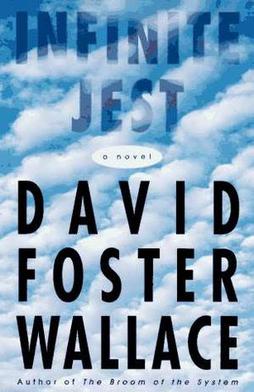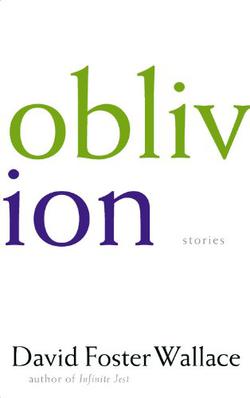
David Foster Wallace was an American novelist, short story writer, essayist, and university professor of English and creative writing. Wallace's 1996 novel Infinite Jest was cited by Time magazine as one of the 100 best English-language novels from 1923 to 2005. His posthumous novel, The Pale King (2011), was a finalist for the Pulitzer Prize for Fiction in 2012. The Los Angeles Times's David Ulin called Wallace "one of the most influential and innovative writers of the last twenty years".

Tragicomedy is a literary genre that blends aspects of both tragic and comic forms. Most often seen in dramatic literature, the term can describe either a tragic play which contains enough comic elements to lighten the overall mood or a serious play with a happy ending. Tragicomedy, as its name implies, invokes the intended response of both the tragedy and the comedy in the audience, the former being a genre based on human suffering that invokes an accompanying catharsis and the latter being a genre intended to be humorous or amusing by inducing laughter.

Jonathan Earl Franzen is an American novelist and essayist. His 2001 novel The Corrections, a sprawling, satirical family drama, drew widespread critical acclaim, earned Franzen a National Book Award, was a Pulitzer Prize for Fiction finalist, earned a James Tait Black Memorial Prize, and was shortlisted for the International Dublin Literary Award. His novel Freedom (2010) garnered similar praise and led to an appearance on the cover of Time magazine alongside the headline "Great American Novelist". Franzen's latest novel Crossroads was published in 2021, and is the first in a projected trilogy.

Postmodern literature is a form of literature that is characterized by the use of metafiction, unreliable narration, self-reflexivity, intertextuality, and which often thematizes both historical and political issues. This style of experimental literature emerged strongly in the United States in the 1960s through the writings of authors such as Kurt Vonnegut, Thomas Pynchon, William Gaddis, Philip K. Dick, Kathy Acker, and John Barth. Postmodernists often challenge authorities, which has been seen as a symptom of the fact that this style of literature first emerged in the context of political tendencies in the 1960s. This inspiration is, among other things, seen through how postmodern literature is highly self-reflexive about the political issues it speaks to.

Infinite Jest is a 1996 novel by American writer David Foster Wallace. Categorized as an encyclopedic novel, Infinite Jest is featured in Time magazine's list of the 100 best English-language novels published between 1923 and 2005.
Hysterical realism is a term coined in 2000 by English critic James Wood to describe what he sees as a literary genre typified by a strong contrast between elaborately absurd prose, plotting, or characterization, on the one hand, and careful, detailed investigations of real, specific social phenomena on the other. It is also known as recherché postmodernism.

Lawrence F. McCaffery Jr. is an American literary critic, editor, and retired professor of English and comparative literature at San Diego State University. His work and teaching focuses on postmodern literature, contemporary fiction, and Bruce Springsteen. He also played a role in helping to establish science fiction as a major literary genre.

Oblivion: Stories (2004) is a collection of short fiction by the American writer David Foster Wallace. Oblivion is Wallace's third and last short story collection and was listed as a 2004 New York Times Notable Book of the Year. In the stories, Wallace explores the nature of reality, dreams, trauma, and the "dynamics of consciousness." The story "Good Old Neon" was included in The O. Henry Prize Stories 2002.
Infinite Summer was an online book club–style project started by writer Matthew Baldwin. Sponsored by The Morning News, participants were challenged to read David Foster Wallace's novel Infinite Jest at a rate of about 75 pages a week from June 21 to September 22, 2009.

Although of Course You End Up Becoming Yourself: A Road Trip with David Foster Wallace is a 2010 memoir by David Lipsky, about a five-day road trip with the author David Foster Wallace. It is based upon a Rolling Stone magazine story that received the National Magazine Award.

David Foster Wallace (1962–2008) was an American author of novels, essays, and short stories. In addition to writing, Wallace was employed as a professor at Illinois State University in Normal, Illinois, and Pomona College in Claremont, California.

The 2012 Pulitzer Prizes were awarded on April 16, 2012, by the Pulitzer Prize Board for work during the 2011 calendar year. The deadline for submitting entries was January 25, 2012. For the first time, all entries for journalism were required to be submitted electronically. In addition, the criteria for the Pulitzer Prize for Local Reporting has been revised to focus on real-time reporting of breaking news. For the eleventh time in Pulitzer's history, no book received the Fiction Prize.

The encyclopedic novel is a literary concept popularised by Edward Mendelson in two 1976 essays referring to a work of fiction with an exhaustive, encyclopedia-like scope and writing style. In Mendelson's formulation, encyclopedic novels "attempt to render the full range of knowledge and beliefs of a national culture, while identifying the ideological perspectives from which that culture shapes and interprets its knowledge". In more general terms, the encyclopedic novel is a long, complex work of fiction that incorporates extensive information, often from specialized disciplines of science and the humanities. Mendelson's essays examine the encyclopedic tendency in the history of literature, considering the Divine Comedy, Don Quixote, Faust, Moby-Dick, and War and Peace, with an emphasis on the modern Ulysses and Gravity's Rainbow. Commonly cited examples of encyclopedic novels in the postmodern period include, in addition to Pynchon, Richard Powers' The Gold Bug Variations (1991), David Foster Wallace's Infinite Jest (1996), and Don DeLillo's Underworld (1997). Other literary critics have explored the concept since, attempting to understand the function and effect of "encyclopedic" narratives, and coining the related terms systems novel and maximalist novel.

Lee Konstantinou is an associate professor of English Literature at University of Maryland, College Park.
A fragmentary novel is a novel made of fragments, vignettes, segments, documents or chapters that can be read in isolation and/or as part of the greater whole of the book. These novels typically lack a traditional plot or set of characters and often are the product of a cultural crisis. The oldest fragmentary novels are part of the (proto)-picaresque novel tradition. Some of these fragmented novels are also categorized as short story collections or epistolary novels. Some fragmentary novels are (posthumously) published unfinished novels or are partially lost novels.

Suzanne Keen is a literary scholar, feminist critic, a poet, author and academic administrator. She was W. M. Keck Foundation Presidential Chair and Professor of English at Scripps College, the women's college of the Claremont Colleges. Previously she served as Dean of the College at Washington and Lee University and Vice President for Academic Affairs, Dean of Faculty, and Professor of Literature at Hamilton College. She became president of Scripps College on July 1, 2022. Dr. Keen announced her resignation from Scripps College effective March 20, 2023. Her resignation letter states she intends to return to teaching at Scripps after a sabbatical on the East Coast to be near elderly family members.
Bennett Sims is an American fiction writer with three book publications, the novel A Questionable Shape and the short story collections White Dialogues and Other Minds and Other Stories. He is an assistant professor at the University of Iowa.

Something to Do with Paying Attention is a novella excerpted from The Pale King and touted as David Foster Wallace's final work of fiction by The New Yorker. It was published by McNally Editions and distributed by Simon & Schuster on April 5, 2022.
Systems novel is a literary genre named by Tom LeClair in his 1987 book In the Loop: Don DeLillo and the Systems Novel, and explored further in LeClair's 1989 book, The Art of Excess: Mastery in Contemporary American Fiction. LeClair used systems theory to critique novels by authors including Thomas Pynchon, William Gaddis and Ursula Le Guin. Citing Fritjof Capra's description of systems theory as a "new vision of reality" LeClair invoked ideas from thinkers such as James Lovelock, Gregory Bateson and Douglas Hofstadter to analyse how the novels in question depicted processes and relationships within social, cultural, economic and political systems. LeClair's systems novels were all "long, large and dense" and all in some way striving for "mastery", showing similarity to Moby-Dick and Absalom, Absalom! in "range of reference, artistic sophistication, and desire for profound effect."













